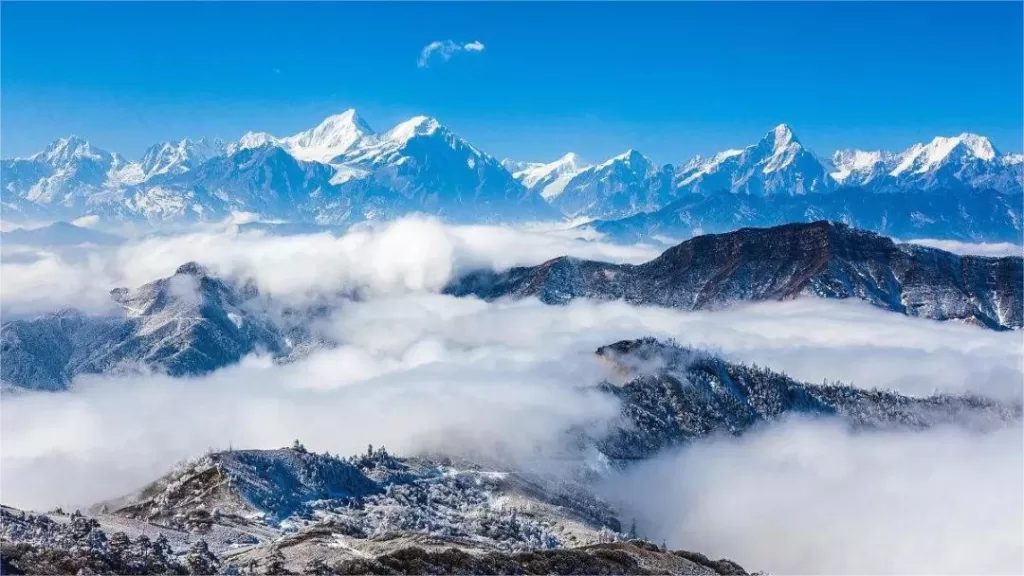Mount Gongga, also known as Minya Konka, is a majestic and intriguing peak located in the eastern part of the Tibetan Plateau, within the Sichuan province of China. As one of the highest mountains in the world and the highest peak in Sichuan, Mount Gongga has captivated mountaineers, adventurers, and nature enthusiasts for centuries. Here are some intriguing facts about this remarkable mountain:
Elevation and Location: Standing tall at an impressive height of 7,556 meters (24,790 feet) above sea level, Mount Gongga is the third-highest peak in China and the highest outside of the Himalayas and Karakoram ranges. It is situated in the Daxue Mountain range, which is a part of the Hengduan Mountains, renowned for its rugged terrain and extreme beauty.
Glacial Coverage: Mount Gongga is heavily glaciated, with more than twenty glaciers covering its slopes. These immense glaciers have shaped the landscape over millennia and are a significant source of water for the surrounding areas, feeding numerous rivers and streams that flow through the region.
Sacred Mountain: For the local Tibetans, Mount Gongga is considered a sacred mountain and holds deep spiritual significance. It is often referred to as “The King of Sichuan Mountains” and has been a site for pilgrimage and religious rituals for centuries.
First Ascent: The first recorded successful ascent of Mount Gongga was in 1932 by a team of American and British climbers, led by Joseph Rock. Since then, numerous attempts have been made to conquer the peak, but it remains a challenging and technical climb, drawing experienced mountaineers from around the globe.
Biodiversity: The region surrounding Mount Gongga is rich in biodiversity, with a wide variety of flora and fauna. The lower slopes are covered in dense temperate forests, while the higher elevations feature alpine meadows and sparse vegetation. The area is also home to elusive and rare wildlife, such as the endangered giant panda and the elusive snow leopard.
Gongga Hot Springs: Near the base of the mountain, there are natural hot springs that have become popular among tourists and trekkers. These geothermal springs offer a relaxing and therapeutic experience, especially after long treks and climbs in the area.
Challenges and Dangers: Climbing Mount Gongga is not for the faint of heart. The extreme altitude, unpredictable weather conditions, and challenging terrain make it a demanding and dangerous undertaking. Proper training, experience, and equipment are essential for any expedition attempting to reach the summit.
Cultural Significance: Besides being a sacred mountain for Tibetans, the region around Mount Gongga is home to diverse ethnic groups, including Tibetan, Qiang, and Hui communities. Each group has its unique customs, traditions, and architecture, making the area a melting pot of cultural experiences for travelers.
Nature Reserves: To protect the exceptional natural beauty and unique ecosystems of the region, the Chinese government has designated several nature reserves around Mount Gongga. These reserves aim to preserve the diverse wildlife, plants, and landscapes, making it an important area for conservation efforts.
Trekking and Photography: For those who may not attempt the summit, trekking around Mount Gongga is a popular alternative. The routes offer breathtaking views of the mountain and its surrounding landscapes, providing ample opportunities for photography and a chance to immerse oneself in the awe-inspiring beauty of the region.
Mount Gongga’s combination of imposing height, stunning scenery, and cultural significance makes it an enticing destination for mountaineers and travelers seeking a unique and rewarding experience in the heart of the Tibetan Plateau. However, its remote location and challenging conditions demand respect and careful planning for those who dare to explore its heights.

